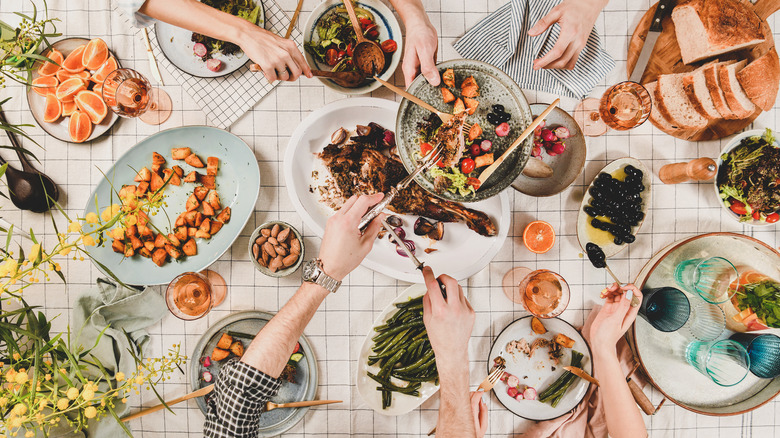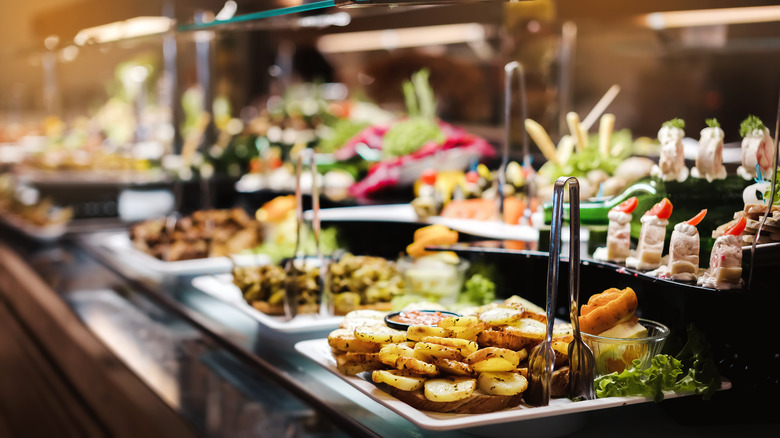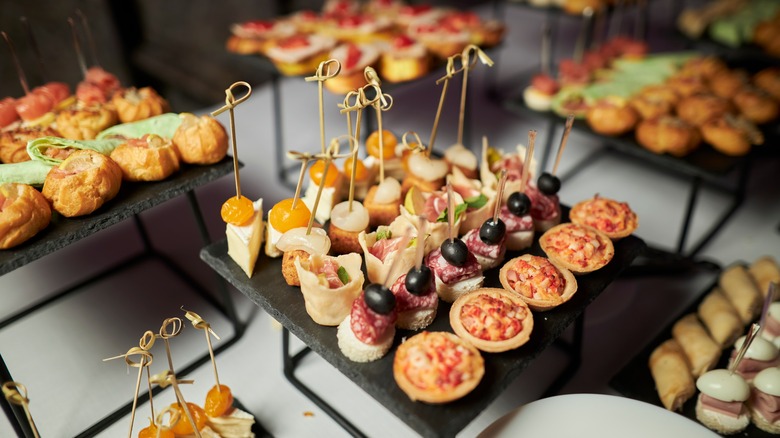The Psychological Trick To Encourage Guests To Reach For More Snacks
You're hosting a party — Whether it be big, small, private, or even a birthday or wedding, it doesn't matter so long as you're the one hosting it. Like any decent host, you made snacks, things like a charcuterie board, mixed nuts, salsa and chips, maybe even a big fondue pot of melted cheese with breads and crackers to dip. You've put a lot of work into making these snacks, and yet no one's really lunging for them. It's like they think that you put poison in one of the cheese dips, and they don't want to take any risks. Why is it that you find yourself with guests who don't seem to want to eat?
The reasons for their behavior are many. It may be to avoid looking like a pig going right for the snack table, something that The Guardian attributes to people trying to avoid being seen as "greedy dinner guests." The Chicago Tribune also reasons it could be that some of your guests may not exactly be fans of the type of food you serve and are simply trying to be nice by avoiding it. Whether they're picky eaters or simply don't want to look like they're animals heading right to the free food, you still want your guests to know it's okay for them to let loose and enjoy themselves.
Fortunately, there's one psychological trick you can "pull" on your guests into getting them to dig into the appetizers.
You're going to have to use some olives
By psychological, we don't mean having to go full-on Freud or Jung on your guests. We instead refer to the idea of "nudging" them a little, kind of like making a subtle implication, to go and help themselves to the snack table. But how can this be done using olives, of all things?
Lifehacker suggests that you take a bowl or ramekin full of olives, eat one, and then put the olive seed in another bowl or ramekin next to the full bowl. This not only showcases where guests should spit their olive pits into, rather than back into the bowl of olives, but it also encourages them by showing that "someone" already broke the ice and went to eat, so they should too. Think of it like having a conversation with a group of people — no one wants to be the first to say something, but when someone finally speaks up, everyone starts talking.
If you don't have any olives, that's okay. You could do this trick with just about any food. If you have a cake, for example, you could cut a slice for yourself and set it out to encourage people to cut it for themselves. If you have a tray of sandwiches, you could cut one into smaller pieces and leave it on a plate beside the tray. You're not trying to make a mess, but instead, encourage your guests to come and eat.
When should you serve snacks at a party?
Let's say that you're not just worried about getting guests to eat the snacks you worked so hard on, but you don't know what time to bring them out. How much should you make, or how little should you make? Should you have a specific time in mind so you aren't "overburdening" people with food?
According to Clise Etiquette, if your party falls between the hours of 6:00 p.m. and 9:00 p.m., you should focus more on the main entrée than on light appetizers and snacks. This helps free you up to prepare the main dish and keeps your guests from stuffing themselves with dips, meats, and cheeses. If your party is a bit earlier, say between 3:00 p.m. to 6:00 p.m., it's suggested that you can bring out the snacks and appetizers, as this is considered the "happy hour" after lunch, but not right before dinner.
Best Dallas Catering's advice also focuses on time, recommending that you prepare the food in accordance with the length of the party. If the party is going to be long, then you should prepare a lot of food. Although people will tend to eat more during the first hour of the party as they get into the swing of things, it's not uncommon for them to eat more as they wait for dinner or the main entrée. Preparing the appropriate amount of food will help keep guests satisfied, but it will also make sure they are hungry for more.


